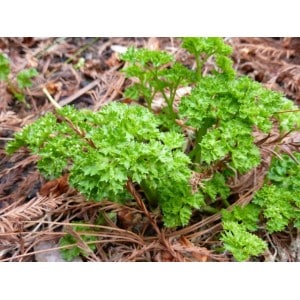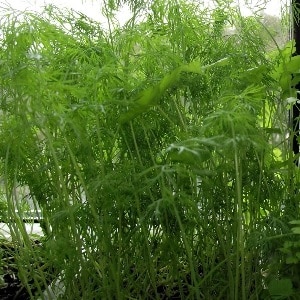When to sow parsley and dill before winter and is it possible to do it?
Parsley and dill are widely used in cooking. They are included in salads, appetizers, marinades, first and second courses. Greens can be easily grow on a personal plot or summer cottage. To get an early harvest, many gardeners use the winter method of planting seeds.
This sowing option has its own characteristics, which we will discuss in the article.
Is it possible to sow parsley and dill before winter?

Parsley and dill are plant crops with high frost resistance. When sowing in autumn, the greens sprout quickly and amicably immediately after the snow melts. If seeds are sown in spring, their germination rate will be significantly lower.
This phenomenon is explained by two reasons:
- The seeds contain essential oils that delay germination and prevent the absorption of moisture necessary for germination.
- In spring, the soil may not be sufficiently moistened.
Seed material planted before winter not only tolerates frosts down to -4°C, but also receives a lot of moisture when the snow melts. A large amount of water in the soil promotes the leaching of essential oils, which ensures rapid swelling of seeds and their germination.
The best varieties for winter cultivation
On garden plots and summer cottages grow both root and leaf types of parsley. The variety for planting is chosen depending on the purpose of the plant crop.
The following varieties are most often planted before winter:
- Sugar. It has a high leaf rosette and a conical root crop. Ripens early.It has excellent taste qualities of roots and leaves.
- Russian size. Refers to root species. The underground part reaches a length of 30 cm. The pulp is white with a pleasant aroma and excellent taste.
- Eagle The root variety is undemanding to growing conditions. It has lush greenery and a pronounced aroma.
- Ordinary leaf. It has a pleasant taste. It tolerates low temperatures well and germinates quickly in spring.
- Italian giant. Refers to mid-season varieties. Produces lush and fragrant greenery that grows back quickly after cutting.
- Esmeralda. The leaves of the plant have a corrugated shape. Due to their decorative appearance, they are often used to decorate a variety of dishes.
When planting dill before winter, choose zoned varieties that are suitable for a specific climate zone.
The most popular among gardeners are:
- Gribovsky. It has a spreading bush with a small rosette about 30 cm high. The leaves reach a length of 20 cm. The variety is well suited for growing in open ground. Contains a large amount of vitamins and essential oils. Positively affects digestion.
- Kibray. Refers to late-ripening and highly productive varieties. Up to 80 g of greens are collected from one bush. It has large leaves of light green color with a delicate aroma. It has excellent taste and is undemanding to care.
When is the best time to plant
The timing of sowing seeds may differ for different climatic zones. Depending on the weather, greens are planted in October-early December. A necessary condition for winter sowing is stable cooling. The air temperature should be around 0°C. Select a time when the soil freezes at night and thaws during the day.
Reference! If snow is already falling, this will not be an obstacle to sowing. The snow is simply swept away from the garden bed and the seeds are planted.
Features of planting in the cold season
Planting greenery before winter has its own characteristics and advantages. The harvest will be as early as possible. Plants are actively germinating, strong and strong shoots appear. They are edible immediately after the snow melts.
Attention! Early harvesting of greenery makes it possible to reuse this area.
How to choose the right place
For sowing seeds, choose open areas that warm up well in the sun and where the snow quickly melts in the spring. A good option for a garden bed is southern slopes.
 You can choose a place for planting under the crown of a tree - there is no risk of shading, since greenery appears much earlier than the buds bloom.
You can choose a place for planting under the crown of a tree - there is no risk of shading, since greenery appears much earlier than the buds bloom.
It is not recommended to use the site in the shade of buildings and fences. When sowing parsley and dill in winter, lowlands should also be avoided.
When choosing a location, keep in mind that greenery is demanding on the composition of the soil. Plant crops love fertile, organic-rich soil with a light and loose structure. The best option for growing them is soil with neutral acidity.
Reference. Dill and parsley do not grow well in acidic soil. However, excessive liming is also not recommended, since if there is too much lime in the garden bed, the dill will change color from green to red.
It is useful to plant seeds in areas where they were previously grown:
- cabbage;
- potato;
- cucumbers;
- beets;
- carrot.
Planting and growing technology
Although parsley and dill do not require care, when growing these crops it is worth taking into account the peculiarities of agricultural technology.
Seed preparation
Winter sowing of greens does not require soaking, dressing or germination of planting material.
Attention! Before winter, the seeds are placed in the ground dry.
During planting and after it, do not water the soil, since any measure aimed at stimulating seed germination can lead to the death of the plant crop.
Damaged and low-quality seeds are discarded upon inspection.
Soil preparation
The soil for parsley and dill begins to be prepared several weeks in advance. In the selected area, weeds are carefully selected, carefully removing their root system.
During digging, compost or humus is added and a small amount of mineral fertilizers are added. For 1 sq. m of land, it is recommended to use a composition that includes:
- ammonium nitrate (15 g);
- superphosphate (10 g);
- potassium salt (10 g).
The bed is well loosened and leveled with a rake. To prevent the germination of weeds and waterlogging of the soil, the prepared area is covered with slate, roofing felt, cardboard or pine branches.
Landing

When sowing dill and parsley, adhere to the following rules:
- Seed material is placed in furrows to a depth of 5 cm, leaving a distance between rows of 10-15 cm.
- The seeds are placed more densely, since some of the planting material may freeze during the cold period.
- To obtain a more uniform sowing, use dry river sand. It is pre-mixed with green seeds.
- Fill the furrows with a mixture of soil, peat, humus and sand. This composition not only protects well in frosts, but also promotes rapid germination of seed material in the spring.
Then the bed is covered with mulch (fallen leaves, hay, straw, pine paws).
Attention! When growing greens, it is recommended to place the rows from north to south so that they are evenly heated by the sun throughout the day.
Before winter, dill can also be sown according to a different scheme. The seeds are fanned out over the area, and a small amount of humus and mulch is scattered on top. With this method it is possible to obtain a higher yield of greens.
Features of care
When caring for greenery, the following agrotechnical measures are carried out:
- Watering. In spring, the soil is moistened as needed several times a week. Water in the evening. During the hot period, the amount of watering is increased so that the plants do not form flower stalks.
- Top dressing. If in the fall, when preparing the site, the soil was enriched with mineral and organic fertilizers, the greens will not need additional feeding in the next season.
- Weeding and loosening. Regularly remove weeds and loosen the soil. This is done 1-2 times a month.
- Shelter from the heat. In hot weather, it is advisable to shade the greens so that they do not wilt. To do this, use opaque material, which is fixed on special stands.
- Pest control. To protect plants, tobacco dust, harmless to the body, is used. It is mixed with sand in equal proportions and sprinkled on the bed around the bushes.
- Treatment diseases. The use of modern biological agents that are safe for health is shown.
Conclusion
Autumn planting of crops has a number of advantages over spring sowing. With this method, vitamin-rich greens are obtained from the plot in early spring, when other vegetable crops are just beginning to be planted.
A correctly selected variety and compliance with recommended agricultural practices guarantee a rich harvest of dill and parsley.